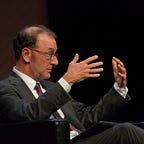AccuWeather CEO misleads on global warming and extreme heat waves
Published in
2 min readAug 9, 2019
Disappointing to learn that the CEO of AccuWeather has evolved from a climate-change denier to merely a climate-change doubter, but this article describes the scientific connection between global warming and heat waves.
- The U.S. government’s National Climate Assessment, published in 2018 and signed off on by 13 federal agencies, flat out states — with very high confidence — that the frequency of heat waves has increased since the mid-1960s.
- But most of the heat records were set in the 1930s! Therefore, you can’t argue that it’s worse now. Turns out you can: “The heat waves of the 1930s were exacerbated by land mismanagement tied to the Dust Bowl. A combination of springtime drought and farming practices left fields bare of vegetation, which allowed summer temperatures to skyrocket. In other words, the extreme heat of the 1930s is a reflection of specific circumstances in that decade and does not invalidate a link between today’s heat waves and climate change.”
- Although the heat waves in the 1930s may have had higher daytime temperatures, present-day nighttime temperatures are much higher. This is an expected outcome of climate change as the atmosphere responds to increased concentrations of greenhouse gases. Today’s steamier nighttime temperatures allow heat stress to build, increasing the risk of heat-related illness and death for vulnerable populations without air-conditioning. So, from the standpoint of extreme nighttime temperatures, present-day heat waves are objectively far worse than those in the 1930s.
- Moreover, temperature measurements in the 1930s may well have been inflated. Many of those temperatures were taken on rooftops and all with mercury thermometers, while modern-day instruments tend to run about 1 degree cooler than mercury.
- [O]nce the data is corrected for instrument changes, station moves, and similar factors, U.S. heat waves are actually slightly worse on average today than in the 1930s
- The heat in the United States in the 1930s was a blip compared to the cool conditions around the rest of the world, whereas today much of the world is uniformly warm, relative to the past,
